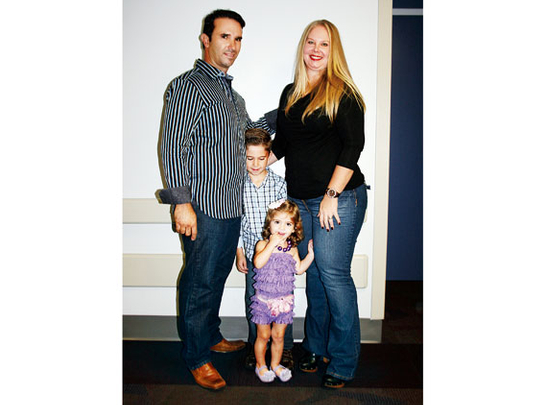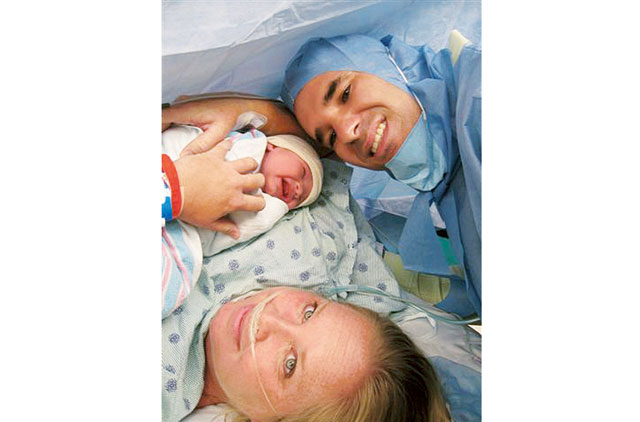
Walking into the hospital, I clutched my husband Alain’s hand. I was 17 weeks pregnant and going for my first scan. Excitement pulsed through me – we were going to see our baby for the first time.
“I hope she has your nose,” Alain, 38, smiled. We knew from an earlier amniocentesis test that we were going to have a baby girl – a little sister for our four-year-old son Alain Joseph, who we called AJ.
I was scared about having the test – it was routine for all women over 35 where I lived in Miami, US, but it carried a risk of miscarriage. So I was terrified as a large needle was inserted into my bump to extract amniotic fluid, which surrounded my baby. The fluid contained cells that could tell if there was anything wrong, such as Down’s syndrome, but luckily everything was normal so we could relax.
Being an older mum I’d worried about everything, but finally we could let go and be excited. We’d even chosen a name for our daughter: Leyna.
Now I gasped as a sonographer squeezed cold gel on to my swollen tummy and ran the transducer over it. I stared at the monitor desperate to see my baby. There, finally among the swirl of black and white dots, we spotted her. “There she is,” Alain said, and I smiled.
Then I peered closer and froze. I could see her little arms and legs flailing, and her head, even her eyes and tiny nose. But right in front of her face was a giant mass that looked like it was attached to her. Fear shot through me.
“What is that?’’ I demanded, but the sonographer had already spotted it and was examining it close-up on the screen. The mass looked like a tennis ball attached to my baby’s face. “I’d like to get a doctor to come and have a look,” she said, hurrying out of the room.
I clutched Alain’s hand, trying not to burst into tears. What was wrong with our baby?
“It’ll be OK,’’ Alain soothed, but I was really scared. How serious was it? I was too afraid to even voice my worries and gulped back air trying to calm myself down. My hand rested instinctively on my bump, protecting our baby.
A few minutes later the sonographer was back with a doctor. “Hello,” he said, running the probe back over my tummy and studying the ultrasound image for what seemed like forever.
No one spoke and as each minute passed I was becoming more worried. “Is everything OK?’’ I finally blurted out.
The doctor’s face was serious. “It is definitely an abnormality, but we need to give you some more tests to find out exactly what it is,’’ he said. They did blood tests and detailed scans. The results would take a couple of days.
Fighting back the tears
All Alain and I could do was to go home and wait. I bit back tears as we picked up AJ from school – I didn’t want him to know how scared I was – but after he’d gone to bed that night I broke down. I tried not to cry, but was unable to stop the tears falling.
“Is Leyna going to be OK?’’ I kept saying as the stream of tears continued to run. Alain hugged me. “I hope so, honey,’’ he said. But the next day the doctor called us in for an emergency meeting.
“What we saw on the ultrasound is a life-threatening tumour,” he announced. “It is feeding off your baby and growing.”
The room spun as I battled to take in the news. “Will she be all right?” I croaked. He explained Leyna had a fetal oral teratoma, a rare, non-cancerous tumour that affects only one in 100,000 pregnancies. Her tumour was almost as big as her face and would grow larger.
“I am sorry, but it is unlikely she will survive,’’ he said. “You can either have a termination now, or if she survives, she will need multiple surgeries as soon as she is born, including a tracheotomy just to breathe.”
The tumour was so huge it was smothering Leyna’s nose and mouth and would end up suffocating her. Even though I was sitting down, I was sure I was going to collapse, so I held on to Alain. “You need to decide what you want to do,” the doctor said. I prayed that he’d made a mistake, but deep down I knew he hadn’t. I’d seen the tumour with my own eyes.
The doctor explained that the tumour was probably the result of the massive cell development that happens as foetuses grow. The main concern was that the tumour was growing so rapidly it could cause bleeding, which would kill my baby.
I couldn’t stop crying. I wanted this baby so much and had been so excited, and now her precious life was in danger.
“What’s wrong, Mummy?’’ AJ asked, finding me in tears. I pretended I’d been peeling onions – he was so thrilled at the prospect of being a big brother I couldn’t tell him I might lose the baby.
Ready to try anything
Alain and I spent a stressful few days discussing our options. It was the most horrible feeling you could ever imagine; physically, emotionally and mentally.
Eventually in desperation I called my gynaecologist at the University of Miami/ Jackson Memorial Hospital. “Surely there is someone who can do something for the baby while she’s still in the womb?’’ I asked.
He was silent for a moment. Then he said, “Well, there might be… Dr Ruben Quintero does surgery in utero, but he has never done anything like this before. It would be a first and I don’t know if it will work.’’
I didn’t hesitate. “It’s worth a try,’’ I replied. And my gynaecologist promised he’d make the call then come back to me. By some kind of miracle, Dr Quintero, a pioneer in foetal medicine who had already treated many high-risk conditions in babies still in the womb, was in Miami where we lived.
We had a nervous week before it was confirmed that he would attempt the surgery on Leyna at Jackson Memorial Hospital.
I went to meet him and his wife, foetal surgeon Eftichia Kontopoulos, who would be assisting in theatre. There was a risk of miscarriage with the surgery. “Or we could puncture your womb by mistake,” Dr Quintero said. “Are you willing to take the risk?” I nodded. If there was a chance of saving Leyna, I was prepared to try anything.
So at 20 weeks pregnant, in May 2010, I was prepped for the surgery. This was a world first. No one had ever attempted surgery to remove a tumour in utero before, but he was willing to try. I was nervous as I was wheeled into the theatre, but I was also quite emotional.
“Thank you so much for trying to help me and my baby,” I said, tears welling. I knew that they would help her.
I was kept awake during the operation and given only local anaesthesia, so I watched the operation on a screen.
Dr Quintero made a small incision above my belly button and, guided by an ultrasound, he used an endoscope to look inside. The tumour was the size of a peach and attached to the inside of Leyna’s mouth. It was removed by laser and I saw it float away from her face. It took an hour, then the laser sealed the wound so she wouldn’t bleed. Relieved, I burst into tears. I could finally see my baby’s face. “She’s beautiful,” I said.
The surgeon assured me Leyna was fine and would only have a tiny scar on her lip. “It went well,” he smiled.
The tumour stayed in the womb with Leyna, but now that it no longer had a blood supply, it started to shrink.
We had to check on Leyna every week, but thankfully the rest of my pregnancy was easy, and eventually the day came for my scheduled Caesarean. I couldn’t wait to finally meet Leyna, but I was still apprehensive. Would she have a huge scar on her face?
But my fears were unfounded, as Leyna was born weighing just over 3.6 kilograms (8lb), perfectly healthy with only a tiny scar near the corner of her mouth to show from the operation. The tumour was found in the womb and had shrunk to just slightly bigger than a one-dirham coin.
“I love you,” I said, cradling her in my arms. She blinked and went to sleep – and she has been an amazing little girl ever since.
She is now three years old, growing well and perfectly normal. The doctors say that because they were able to remove the entire tumour during the procedure, it’s highly unlikely to return. But after lots of tests when she was first born we’ve never had to take her back for check-ups.
Leyna means ‘little angel’, and that is exactly what she is to us. Every now and again I look at the ultrasound scan and am stunned by the sight of her tumour. I’m so grateful that we were offered such pioneering surgery – it saved our beautiful little girl’s life.
Tammy Gonzalez, 39, lives in Miami, Florida, US












